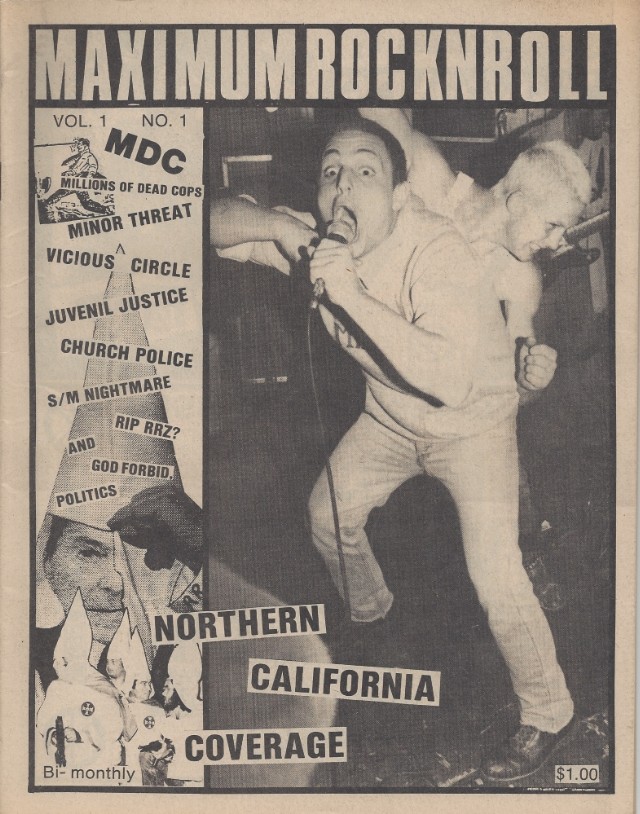
On today’s episode, Maximum Rocknoll – the story behind the famed punk institution.
Beginning in 1977, a group of Bay Area music fans led by Tim Yohannan, began a weekly radio show out of the studio at KPFA in Berkeley, California. The driving impulse behind the show was simple – an unabashed uncompromising world of punk rock. By 1982, the punk scene had grown into a worldwide movement and the founders of the show launched Maximum RocknRoll as a print fanzine, dedicated to anti-corporate ideals, leftist politics and relentless enthusiasm for DIY punk and hardcore bands from every inhabited continent of the globe. Over the next several decades, what started as a do it yourself labor of love amongst a handful of friends had extended to include literally thousands of volunteers and hundreds of thousands of readers. For many, it became the punk rock bible. The inky smudge of the black and white newsprint providing a voice in community for young teenagers around the world, introducing them to bands and a sense of creative expression they had not known before. By 2019, the landscape of the punk underground as well as print media itself had dramatically shifted and MRR announced the end to its print publication. Over these 42 years with over 1600 radio shows and 400 issues of fanzine to its claim, MRR came to represent a certain do-it-yourself ethos that extended far beyond the music itself.
As the print scene came to an end last year, I invited some well the longstanding Maximum contributors to come together for a night to talk about that the zine and its lasting impact on the global punk scene. Here’s our conversation..
The Past, Present & Future of Maximum Rocknroll: The Story Behind the Famed Punk Institution
Brandi Howell (BH): Tonight we have with us Martin Sprouse, Paul Curran, and Matt Badenhop. And before I introduce them, I just wanted to play a little taste of the early days of the radio show.
Maximum Rocknroll Sampler
BH: So if you guys wanted to introduce yourselves a bit and kind of give your background and how you were first introduced to the magazine.
Martin Sprouse (MS): Yeah. My name is Martin Sprouse. I grew up in Southern California. So my first introduction to the magazine was the first compilation. Me and my friend, Jason Traeger, and Pat Weakland. We were doing our own fanzine in San Diego called The Leading Edge. And we found that record, Pat knew it was coming out and we found like the day they were unboxing it in a record store and we just go – Oh wow! Cause it was the first time we knew there were hardcore bands playing up here, you know, that they existed up here. Because in Southern California, we’re spoiled with them, but it was nice to see all these kids doing things. And then from that our local record store started carrying Maximum Rocknroll from the first issue on. And when we first looked at it, it was like so different than what we’re used to. You know, we’re used to Flip Side and Ripper, but Maximum to our teenage eyes was this thick. It had politics right on the cover and I was going – Holy shit, this is great! You know, it was newsprint, it was messy, just like it is now, you know, but it just looks so different, you know, and then we just kept buying issues. And we started coming up here and visiting in ’84, ’83 … staying at the Maximum house. And then I moved up here in ’85 to become part of Maximum. Is that enough background? And I stopped doing Leading Edge and started working on Maximum and been involved with Maximum projects since then.
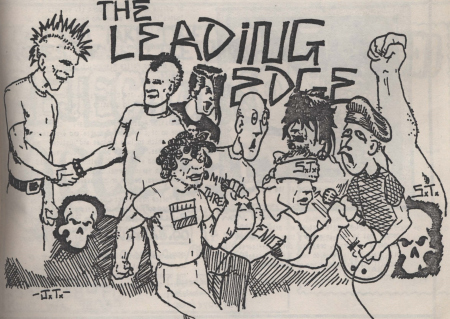
BH: And Paul has also been with the magazine and various bands since 1983, contributing to all the graphics and the record reviews, he lists himself has a house cleaner. And now as a member of the powerful and mysterious MMR board. Paul, how did you first learn about Maximum?
Paul Curran (PC): I first learned about Maximum probably by seeing the magazine. I grew up in Benicia, which is a suburb…kind of far out suburb of the Bay area. But my dad lived in Berkeley on Telegraph Avenue. So I would come visit my dad and just hang out on Telegraph. And I think I saw it MRR in Universal Records, which was a olden days record store. And on page two or three, it shows where the radio show is broadcast. And it was broadcast locally on KPFA, which is a very powerful signal. And so I could get it out in Benicia and just listened to MRR and learn about punk rock. And, yeah, having that Berkeley connection… I, boy, I’m just, I was just like thinking like how much detail to tell, but, when you listen to the radio show, they would just tell people, like call in if you want to be a guest DJ, it was that simple. And I was like, Oh, I want to be a guest DJ. So I called in and I was a guest DJ. And through that connection ended up volunteering at the magazine, doing little paste up layouts of things. And it’s all downhill from there.
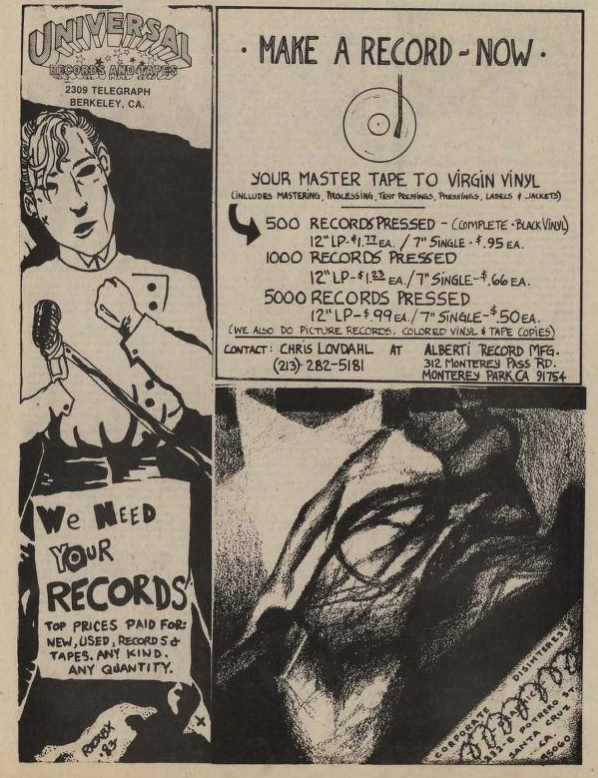
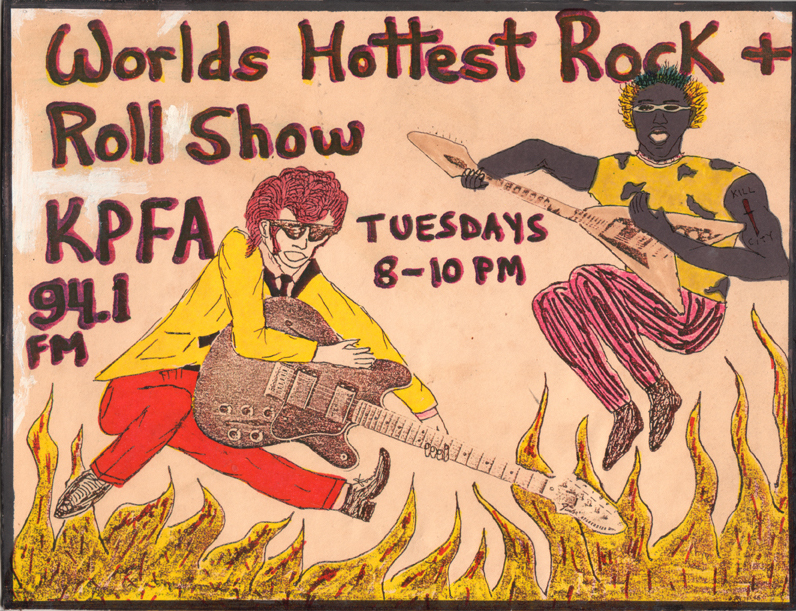
BH: And Matt, you first came, moved to the Bay Area in 2011?
Matt Badenhop (MB): Yeah, I was just thinking when Martin was talking, my getting involved with the magazine was kind of the same, but like many years later, like in the mid to late nineties. But I grew up in the suburbs of Dallas and me and my friends found it at Borders from from that big distribution that we were doing so, and then we, you know, as we started doing bands and touring and stuff, we would come out here and stay at the house and yeah, just, you know, knew a lot of the people connected to the magazine by that time. So naturally when I moved out here in 2011, I got recruited as a record reviewer and do radio show and all the other stuff now, too.
BH: And Martin, I was wondering if we could step back and just kind of give a background of Tim and sort of who Tim Yohannan was, the founder of this, the legacy.
MS: I don’t know how many people met Tim or just knew of him afterwards, but yeah, he was a pretty insane, but very special dude. I mean, some of his best characteristics was he loved fucking punk rock. He loved music, you know, just full on everything about it. And he loved, he was very, he’s one of the few people I met that has a very strategic mind. He’s always like 20 steps of everybody else. Not in a competitive way, but just thinking about new things, new projects, just to keep pushing forward, it was pretty amazing. He was not shy to do things that have never been done before. And he also had this laugh. Yeah. Everyone remembers the laugh, but you know…
BH: I feel like all the like, cause Dirk [Dirksen] had such a laugh… there’s another impresario of famous punk club that also had like, yeah,…
MS: Yeah…Tim, Dirk and Jello [Biafra]… put them in a room together, craziest punk rock history thing, and just these very crazy personalities. And when they’re all together, it’s pretty amazing. But yeah. And Tim Yo, he was just, I mean, there’s so much bullshit that’s come out since he died. Like, people weren’t really there, but they were just always talking shit about like he controlled everybody. It was just like this communist house and all that shit, but that was all, none of that that’s even remotely true. But also Tim was really open to bringing people into the projects. Like 13 year old kids, you know, barely know how to play instruments. He’d play their demo on the radio show. Someone said they want to write a review at Maximum. And there they live in East Bay. He’d make sure they get over here and write reviews. I mean, that was a special quality and that was honest. He didn’t, it wasn’t something he was trying to do. It was just second nature to them. It’s also just being part of the punk community. part of Maximum. And also a lot of other people had a lot of say in Maximum. It wasn’t just, it wasn’t a dictatorship at all. It was always this, whoever did the most work got the most say, it’s just kind of how organically Maximum’s structure worked.
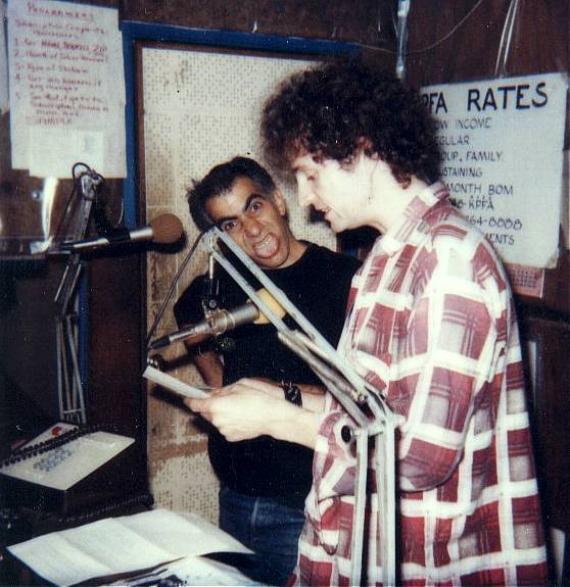
BH: And you personally making the decision to move…you’re a teenager when you moved. Left San Diego and moved up and moved into punk rock house. And like, what was that decision based on?
MS: I forgot to mention, I was writing some reports for Maximum – San Diego scene reports. I don’t know, like ’83, I don’t know for a while there. And just coming up here and visiting and the whole weird story about me moving up here, I’ll make this really quick is me and my friend Jason were up here visiting and,Joan and Bessie from The Wrecks who were on the first compilation. They were…this was all in the first Maximum Rocknroll house over in Berkeley, right? Yeah. Oakland – Berkeley, right on the border there. And all of us were hanging out. And when we’re done hanging out that weekend, Tim set us aside and proposed that me, Bessie and Jason come and move up here and take over the magazine. This is ’84 and it’s because he wanted to start a punk club. And that was the very beginning of Gilman. At least the idea. So what happened is Joan and Jason didn’t want to move up here. So I moved up here by myself and it wasn’t really, we didn’t really use the term coordinators yet, but I came up here and just had a pretty big role in the magazine. So that was it.
Yeah. Moving the house moved from Oakland, Berkeley over to Clipper Street in the city. And also, I remember I was down in San Diego, I think, 18, 17, or something like that. And Tim would call me up in the afternoon. He goes, yeah. And he would like come back from work and start looking all over the Bay area for place where you can open a punk club, but we also could live. And I was going – Ugh, I’ve been going to punk shows for a long time, but I wouldn’t want to live where their shows were. You know? Cause America was a little different. It wasn’t like European hostile things or squats where it’s nice. It was just like, and he goes, yeah, I found this thing. Maybe we could build bedrooms in the corner. I’m like – Holy shit. I’m not going to live there. You know? But it worked out where he found this really nice house on Clipper and then Gilman Street came a little bit later. Um, What’s the dude’s name? Victor Hayden actually found the building where Gilman started.
So I know that was, I don’t know. I just wanted to be part of Maximum. It was nice. I’d been doing my own fanzine for so long. It just was nice to just be around a large group of people and be in San Francisco. But I was scared shitless. When I moved to San Francisco. The day I moved here as listening to some radio station and Penelope Houston was doing an acoustic version of a Ramones song. And I said – Fuck, man, this is going to be terrible! Really bummed me on. And I liked Penelope and used to like the Ramones, but I just thought it’s going to be so grown up. Things were changing. And it really, I was fearful I made the wrong decision, I mean seriously because San Francisco had older punk scene, you know, and we hadn’t really dived into the East Bay thing. You know, we’re all those amazing hardcore bands that were on the first record. That was truly a fear of mine.
BH: But fear not because Not So Quiet had just come out it…
MS: And also everyone that I knew from magazines started coming over and it had a way more youthful thing as well as it was just a nice collaboration of people that have been around since Day 1 and knew people. That was what that was true for all Maximum projects. And still now, you know.
BH: If you could give a little background about Not So Quiet and kind of the influence, and we have a few clips we can maybe play. So Martin had selected a band 7 Seconds. Can you talk a little bit about the track and then we could give it a listen or we can, let’s just, let’s give it a listen first and then…
MS: Everyone’s going to love it, right?
BH: So this is a selection from the comp that Martin first heard…
BH: So you’re a teenager in San Diego and you hear this song.
MS: It’s 7 Seconds. They’re great.
PS: That’s how long a song should be too.
MS: I think it was 49 seconds. Is it under a minute? Isn’t it? It is anyways. I still love that song. Right? The first seven inch was out and just like, they just had a whole different vibe of what’s going on. Like, you know, Saying, fuck racism. Fuck this. Fuck that…that song was called. Fuck your America, which still holds up.
BH: Had you listened to anything like that before much?
MS: Oh yeah, like I said, I think 7 Seconds’ first seven inch was out by then. And that was a super special 7 inch, Skins Brains and Guts. It’s totally great. And they had a couple of demos out before that, but also just love the sound of that song. It was when 7 seconds was it three-piece then, and I don’t know. Kevin Seconds is a special dude, too. So yeah, that song, I still love that song. I still love every song on that record almost except The Oven is My Friend … Church Police, some band that Jello probably put on that compilation.
BH: I was wondering if you could just share, there are like 42 songs or something on the album, but you know, you can get away with that on an album when they’re like one minute long punk songs, but you were saying the…It’s sort of, so most of them, it was a representation of Northern California hardcore bands, but one band that stood out for you as a band, it like 12 year old kids.
MS: Yeah. This is, this is a whole podcast in itself – very important. This band called The Maniax from Fresno. And this is really just kind of, I’ll make this story as short as possible, but it really shows you what Maximum is about. So there are a bunch of kids that 12, 13 years old, right? Like crazy young. They listened to Maximum radio show like Paul was saying, and then they didn’t even know how to form a band. They didn’t know how to play instruments. They didn’t know anything. And they made this crappy little, like it wasn’t even a demo. It was just a song on a cassette, sent it to the radio show. And there’s a clip of the radio show somewhere where Tim and Jello are just going – Maniax, you guys are great. Give us a call. We want to bring you up here and do things.
PC: Didn’t they say that they just recorded the tape and sent it. Like it wasn’t even a copy of the tape.
MS: No, it was like they made this tape for a Maximum and I think they recorded over like a, you know, some other music, like their parents’ music was just like the scrappy.
BH: An Abba album or some disco…
MS: I know…Tim and Jello were so you, there is a tape and you can hear how enthusiastic they are, and that’s really the essence of Maximum. And then the funny thing quick on the. The song that’s on the Maximum Rocknroll compilation. It’s crazy. It’s the second longest song. The first longest is Flipper, which is almost expected, you know, the droney Flipper thing. Maniax, the guys that didn’t know how to do anything, but just put their heart into it. They had the second longest song. And I think that’s because they didn’t know how to! They didn’t know stop. It goes on forever. And then the other quick thing is you listen to that song and the music or the guitars instruments go in and out. And you’re like, what are these kids about? What are they trying to do?
BH: Surround sound. Yeah.
MS: And then you figure out the story is that they’re in the garage. They didn’t know how to record. So they were towing a little red wagon around them and with a boombox. And then whenever a wagon went near the guitar, you’d hear the guitar. When the wagon went near the drums, you’d hear that, like everyone thought like – Oh, they’re really crazy. These kids, these kids are fucking smart – Fresno! And then you find out like, they just didn’t know how to do anything, which made it even better. And then. For all those that want to know more about it. There was a 15 minute documentary about The Maniax on YouTube that Dale Stewart from Fresno, he’s documenting everything about the Fresno punk scene. And didn’t even think twice just did about The Maniax. And you hear a lot of that story, you know, it’s pretty amazing. But anyways, that’s a perfect example of Maximum Rocknroll, just bringing everybody in and being enthusiastic about kids trying to do something. That is just, it was really amazing. So that’s really the main thing about that and the red wagon, those are two really good points about that story.
BH: And then Paul selection from the album is a song by The Wrecks. Punk is an Attitude. I was wondering if you could cue that up.
BH: So Paul, you’re listening to this as a kid.
PC: No, honestly, if I think back on it, it does baffled me like, cause I didn’t have the foundation of knowing what punk was in the first place. And then to be told, no, it’s not about that. It’s an attitude. And it’s like, I’m just like that whole album is just me absorbing and just trying to figure out what the fuck it was. So, but I think that now in hindsight, like that’s one of the most important songs on there because of, I mean, it being women, first of all, female band. And that was…
BH: Can you talk a little bit about The Wrecks? Do you know much about their origin?
MS: Yeah. I mean, personally, they’re all from Reno. Joan and Bessie Bessie was one of the women I just mentioned that they come up and take over Maximum. They’re from Reno. Bessie and Joan did this amazing fanzine called Paranoia. And it was just so smartassy and crazy. And they just do these funny interviews with all these dude bands. And they were just do this really dry humor and the guys are all thrown off. They were amazing, but the Reno scene had a lot of women, and it was a perfect combination. And then that song was just, you know, it’s like what Paul said. It was really good. And also having an all female band come out, you know?
PC: Yeah. And, I dunno, just thinking I’m going to go see Bikini Kill play in LA tomorrow night…
BH: Yeah. I mean, it seems like it set the stage for a lot of those bands.
PC: Yeah. I mean, it’s…
MS: They don’t get the credit they deserve.
PC: They just, they don’t. Yeah. When riot grrl happened, like people were like – Hey, check it out. Women are playing funk. And you’re just kind of like, well…
MS: Yeah, all those early, all female bands didn’t get the credit as much as they should.
PC: But yeah, Punk is an Attitude, trendy sucks. You know, again, it holds up America. America’s still sucks. Trendies still suck. And here we are.
BH: So if people aren’t familiar with kind of the structure of the magazine, so it was all compiled out of a punk house in the Bay that sort of moved around, but can you kind of talk about the community of shit workers as they’re called, the volunteer base that really put the magazine together throughout the years and what the early days, I mean, there’s such an aesthetic – this is the last issue, but, you know, sort of has that cut and paste zine feel that took a while to put together. Can you talk about just the structure and the layout and design that went into those early issues?
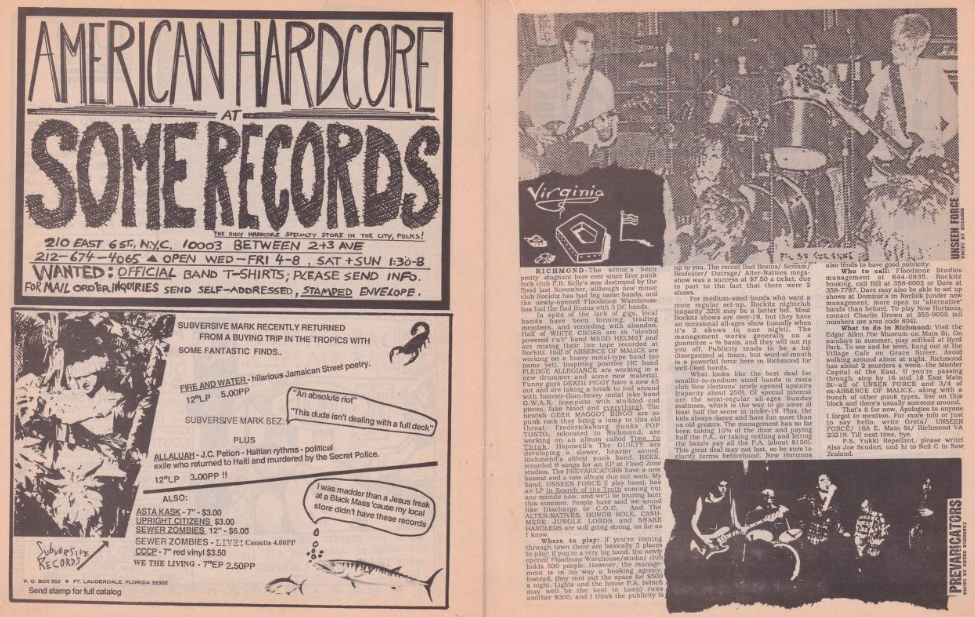
PC: Yeah. Well, again, it comes down a lot to Tim’s powers of organization. He was able to have things together enough to where people could come in and do it. So when I would come in to do a layout, he’d be like, well, you know, here’s all the, here’s the galleys. This is going way back in time for how things used to work. We used to like send things out to get typeset and sent back in these strips that we would cut and have the pictures. Like it had been half toned at a certain size. And so he would have all these things ready and then it’s like here, you know, like have at it. So in a sense, it was kind of like, Yeah, just like inviting random people over to do random work and hope that it gets done right. And on the other hand, it was like the most well oiled machine of the world. And only literally like only Tim could do it. Tim passed away in 1998. Right. And, you know, since then it’s been other people doing that particular job and it’s always taken two or three people to do that amount of work, and it’s still, still kind of too much for two or three people to do. But in the sense that, yeah, there’s, it’s always been contributor based like the, the columns and the interviews, you know, and just people sending their records in for review. It’s always been this thing that people want to be part of and they’re allowed to be part of, and I don’t know these kinds of things get me choked up cause it’s we just finished our last issue.
MS: But also you guys had Sunday work meetings. Right? Remember everyone would come over on Sundays and do layouts and type. Yeah. That was the main way.
BH: And what was the sort of atmosphere of those?
MS: That was, you knew more about it. I came there. I did some work when I was visiting, but yeah.
PC: Oh, it was just, it was exciting to be, you know, as a kid, just to feel part of something and that’s still to this day, the best part of working at Maximum is when a bunch of people are over at the house doing work and we’re listening to records. And, yeah, again, just having that structure for that stuff to come together was what it was all about. And, um, I don’t know what else to say.
MS: Yeah. It was a really great thing. And Tim blamed me for ruining those Sunday work parties.
PC: Why?
MS: Because when I moved up here I’m was like a workaholic. Right. And I just started doing everything in the weekdays before Sunday, then eventually Sunday stuff just kind of faded away and I didn’t want it to be that way. But then Tim just goes, man, you just fucked that up. It’s just you and me sitting here. But a lot of people came over during the week, but they’re just the Sunday work parties faded out within a year or something. So yeah. Yeah, I did that one. Not very good…
BH: And then there’s also, so the zine and then the radio component and the first 10 years or so it was our of KPFA, which is a community station in Berkeley, that’s sort of imagine your typical Berkeley hippies running the station, and then a bunch of punks come in and take over the airwaves. And I just want to… so we have, if you could play the pledge drive clip. So this is a clip from ’81 during the pledge drive of a community public radio station in Berkeley with punks taking over the airwaves
KPFA MRR Pledge Drive
BH: Just a little different than KQED. So anyway, you guys were just kind of taking over the airwaves and there’s always a bit of dynamics between the punks and the hippies, but you guys brought in the most fundraising. So you sort of held the power for a while. Can you talk about sort of those dynamics of the station?
MS: Um, gosh, they didn’t really like us, but they had to like us cause we brought in so much money, but you know, they were just weird Berkeley. You know, wearing ugly shoes and, you know, thinking that, you know, it just didn’t have that respect. And we really, you know, we brought in a lot of money. We respected the station and we really believed in it, but it was always a war with them. And couldn’t really figure out, they’re always trying to give us bad time slots, you know, then they tried to … early on they had a boycott, right? Or they had a protest. What was that over? That was late seventies, maybe.
PC: Yeah.
MS: That was a time slot thing. Wasn’t it?
PC: Yeah. I think that the station had promised them a better time slot if they, you know, had like met certain goals and then they did. And then station said, no, and actually, and then Tim being the organizer, he is, was just like, we’re going to have a demonstration that right outside the radio station. Yeah. Like, and the great irony of, you know, having a having a protest outside the community radio station set up by the children of the free speech movement, you know, it was beautiful. And then, and it was successful and kept going. Yeah. And so they were ended up in a 9:00 to 11:00 PM slot, which. Yeah, to me, it was prime time. That was bedtime. And my parents weren’t going to bug me and I could just listen to punk rock at night.
MS: Yeah. And also another special aspect of when the radio show was there, everyone would come in and hang out at the radio show and where they’re doing, playing the records and Ruth or whoever was running all the turntable stuff. It was just a big hang there. It was amazing. Like all the Berkeley kids, Berkeley punk kids would come there and you just meet a lot of different people. Then the bands would come in there. So it had this really nice community thing based around people playing records and like what Paul was saying, doing guest sets, announcing records. And that was a good thing.
BH: And you can just come in and kind of DJ if you wanted to.
MS: You had to kind of arrange ahead of time. You could announce songs, but if you wanted to do a special set, you’d have to kind of let them know day or two before, but it was just people just listening to music and hanging out and talking. That was amazing.
BH: And I just wanted to play. So going through the archives, they’re like they’re saying, you know, bands would be coming through and would come in and guest DJ and come in for interviews and as I have been going through the archives and there’s a clip from the early days of Sonic Youth when they came through the station. So if you could play that.
Sonic Youth on MRR
BH: I think I just, I really loved hearing that, you know, just this era of life before internet, you know, before they obviously became one of the biggest rock bands a few years later, but here they are just coming through town and if people wanted to write Thurston, like he just gave his address on air. And I’m sure there’s a lot of moments that just like, you know, people coming through and different spontaneous moments, what were some of the highlights of those early radio shows?
PC: I remember being there when The Subhumans from England came and they were like the punkest people I ever saw, they wore leather jackets and had spiky hair stuff and like the Bay area punks, like kind of just dressed in flannels and maybe some boots is how punk as it would get. And like, yeah. And that was just like – Oh man, like there, that was pretty crazy. That also reminded me that like people would come on and there was kind of like the sort of like classified ad element to it. Like, I remember guest DJs being like – And yeah, if you want to treat tapes or anything, just like call me, you know, like give their phone number out, you know, and we totally would like to call those kids up and stuff and like, um, yeah, it was a real community thing. And something that I remember if we’ve touched on yet, but like the KPFA signal is something like 40-50,000 Watts, which is ginormous. And so, you know, most community radio stations are just like pretty, pretty localized things, but that was the entirety of Northern California. If you count that they had sister stations in like Guernville and Fresno and San Jose. So it’s just kind of baffling to think about the reach.
BH: So, you know, Ruth would be copying the tapes every week and distributing them out throughout the country.
PC: Oh, that’s you. Yeah, there were, yeah, it was syndicated like manually syndicated. Yeah. Mailing the tapes to the radio stations every week. Boy. It’s hard to imagine.
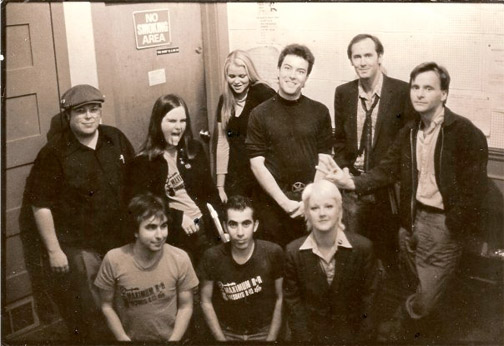
MS: I remember one crazy radio show. It’s when the SF skins came to the radio station to work things out, and this is pre Nazi skins, but SF skins were like the street dudes, Mark Dagger. What were some of those dudes? Man, they were just fucking mean tough dudes, but not Nazis, but street dudes. And they beat the shit out of everybody at punk shows, sucker punch, and it was just nuts. And I think even Tim got punched by one of them. So Tim never fearing conflict or confrontation, invited him to come on the radio show and work things out. And I was at that radio show – Like a fuck. These guys are here? And it was so crazy because they were trying to make peace and some kid called in and he goes, Just some, a young kid, he goes, Oh man, you guys suck, you punch all my friends and the guy goes, no, we don’t. What’s your phone number? Give me your phone number right now. It was just the whole night of that radio show was like that I was really tense and stuff, but again, it wasn’t a Nazi thing. It was just dumb ass, really big skinhead dudes, you know, but that was a very interesting thing of bringing confrontation in, you know.
PC: Also the most famous one was Bill Graham, right? They had.
MS: Oh shit. Yeah. Bill Graham came to the radio station. It’s a good interview. Tim Yo did it, right?
PC: I think Tim and Jeff. Yeah, exactly what they were confronting him about. Just about his strong hold on.
MS: He was trying to get started doing punk shows.. And they were gone no way. A couple of bands had started playing shows a little bigger bands, but yeah, they brought him on and he would just, he was saying, Oh, we can do this all together. And Tim and Jeff just said, no, you’re corporate. And they were just confronting him. It was actually a really interesting interview. I think that was it. Yeah.
BH: What I love so much about the magazine, you know, before everyone said, you know, it was the community that before the internet, you know, you either learned about new bands or listened and exchanged tapes. And there’s even like a pen pal section. Everyone talks about like, Oh, I had pen pals in the eighties and nineties.
MS: That’s how I met everybody, writing letters.
BH: Before social media.
MS: It was the internet, you know, we have pen pals. That’s how me and Winnie met. Winnie right there, he lived in Germany, I lived in the US and we traded fanzines, you know.
BH: That’s amazing.
MS: Yeah. And we’re still friends now, but yeah, that pen pal thing was a huge part. Not just at Maximum, just in the early eighties. That’s how all the bands met or how they all tried to tour the fanzines. Everything was amazing. A lot of those people I’m still friends with today.
BH: No, I think it’s such a like fantastic aspect. I mean, it just demonstrates that…
MS: Yeah, explain it to kid? It’s really weird. What the fuck is a pen pal?
BH: To think these sort of nostalgic correspondence via mail would come out of punk magazine. So anyway, so then you touched about, so when you moved up Tim had this idea that he was going to open a punk club. And at this point the zine was quite profitable and bringing a lot of money in and, but, you know, it was a DIY scene and they used the money to fund other projects. And one of them being, you know, now the most famous punk club, you know, one of them ever, you know, in Gilman Street. And I was wondering if you could talk about. Okay. That first time was Tim was like, Oh, I want to want to start this club.
MS: Yeah. And then that he, you know, the solo thing kind of went away pretty fast and he was bringing people in to help start doing this, you know? Cause it, it wasn’t a Maximum project. I mean, Maximum was making so much money then just from advertising and sales and Tim Yo always wanted to use that money for something else. Cause none of us got paid. So we always tried to give all the money away. So Maximum Rocknroll financed the beginning of Gilman, which was a chunk of money, but we didn’t even feel it. You know? And then what’s really interesting about Gilman is being in the East Bay. A lot of people from the East Bay that weren’t part of the Maximum directly, all came together and it started this whole new community of people that put in a lot of work, like a year’s worth of work to open Gilman, you know?
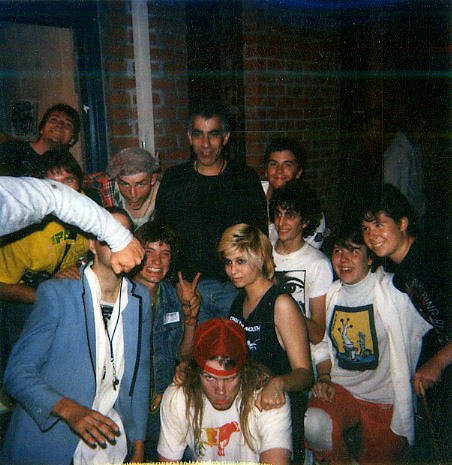
BH: And what was the duration between that initial stage and when it finally opens, how long did it take?
MS: Tim was looking to have us live in a punk warehouse and that was in ’85,’84,’85. And then Gilman actually opened in New Year’s Eve of 87, right? Yeah. And we actually had the lease a year before. We were doing construction and dealing with the city of Berkeley. They didn’t want a punk club opened. One funny thing is they wanted us to pay for like 20 streetlights in that area because they thought we were going to be a moneymaking business and we had to go to the community meeting with Berkeley people. And it was just another, like people in bad shoes telling us what, you know, it’s terrible, man. But we won. Tim Yo, again, organized this thing. People came there and told their own stories. He wasn’t coaching anything. It was just this heartfelt thing because we knew we were doing something right. And that’s way before we even opened, you know? And they still didn’t really like us, but they knew that we didn’t need to pay for 20 street lights, but then they started liking us, you know? Yeah.
BH: And if people aren’t familiar with Gilman, I mean, he knows there’s the music club, but it’s really, again, another DIY community that emerged out of that. You know, unlike The Fillmore or some of these, you know, major venues, it really it’s a community run all nonprofit, volunteer based music club. Can you kind of talk about the ethos behind that. The fundamental values and core behind the club.
PC: Yeah, it was meant to be, well, it was kind of meant to be a safe space before that was even a word because it was the days of… there literally were skinheads, just like randomly showing up and randomly beating random people up. And, um, and this was meant to be a place where that wasn’t tolerated and where. Um, other kinds of I don’t know, just racism, sexism, homophobia. It’s right there on the wall when you walk in…those things were acceptable because it was meant to be for everybody. And yeah, just again, another good example of like building a good foundation for then other people to just come in and run it. And it’s still, it’s still going. Like, it’s pretty amazing. Like it’s been through a lot of ups and downs, but it’s still run under the exact same principles. And, it’s, it’s very remarkable. And, uh, it’s, I don’t know. It’s, it’s almost like not really appreciated that much anymore because it’s so well established and been there forever, but I don’t know… people ought to…
BH: But at the time it was a pretty revolutionary idea.
PC: I was, yeah, I think so. Yeah. I don’t think anybody had done anything like that before. Right?

MS: Like, not like that. Run by punk kids for punk kids, you know, and it was really a hundred percent that way. And everyone did the work. We did the security and we wouldn’t let anybody, you know, that membership card was a way of being able to have people be part of the community and kick people out. You know? So if someone started a fight, we get, this is the reason to throw them out. It’s not like, okay, stop fighting. Let the show go on. We just kicked people out. And you know, we had to do our own security and again, skinheads. This was now becoming suburban skinheads that were more Nazi, racist, white kids. And they’d come to the thing and we’d have huge confrontations with them. Cause if someone started shit, all the bands had to stop. Music was secondary. The community was first and a bunch of scrawny, little punk kids were confronting these, you know, fucking skinheads. They just always are just what they are, you know, and, but we push them out is almost like this, just a blockade. They couldn’t come in and we’d just stand there until they leave. And then a bunch of bad stuff happened when they started beating people outside. But that was one amazing thing where kids just stopped. Cause I came from Southern California that never happened. They were just crazy fights all the time, but this, everyone came together and pushed people out and block the entryway. You know, that’s another huge thing again, that was the community coming together, you know?
BH: And then you kind of have out of that scene, the whole, you know, ’90s East Bay punk that really became synonymous with. Yeah, the punk breaking through in ’94 was big around that time, Turn It Around, another key comp album came, which featured a lot of the East Bay punk scenes. I was wondering if we could play the Op Ivy. So this was a song from Operation Ivy, which was one of the key bands from that era.
BH: And then like all of a sudden punk exploded. And how did that change things at a Maximum when every teenage kid in America was listening to punk and Green Day.
MS: I got a great story about Green Day.
MB: I was wondering when Green Day was going to come up.
MS: Yeah, when they went big Tim was still alive. We were living in the Clipper house and after Green Day sold, I don’t know what, a million records they get these little platinum things or would it be things in frames where they have the album and Green Day, you know, they get to I guess you could do get, how many of you want to give to your producer record label? They made a custom one for Tim Yo and had it delivered to the Maximum house. So he was stuck there with a Green Day platinum thing. It was the best joke they ever pulled on him. It was really, really funny. He just holding this thing now is a really good one. I don’t know where that thing is, but it was like etched and everything came right from the record label, right to the Maximum house with Tim Yo’s name on it. Got to give it up to those guys for that.
MB: Too bad we don’t have that. Now. We probably could’ve saved the magazine.
MS: I don’t know. I think Lance Hahn took it or something. I don’t know, Tim Yo tried to give it away the minute he opened the package, I don’t want that, but he was laughing because he appreciated a smart ass thing.
BH: So speaking of the record, so Matt was one of the last DJ to do a radio show w utilizing the record collection at the house. So Maximum with the closing of the zine also had to put their amazing record collection in storage. But Matt’s last show pulled deep from the archives. I was wondering if you could talk a little bit about the archive.
MB: I mean, when you do a regular radio show at the house, you know, I would always bring some stuff and try to play some new stuff, but then just play whatever I’m listening to. And, since I knew we were going to move, we have like, I don’t know the exact count, but we’re probably at about 60,000 records at this point. I mean, it’s everything from day one. And then everything since, and people still send us stuff for review and it all goes in the archive. So, I just thought, like, if you, you know, the records, we still have them. We don’t have, they’re not publicly like accessible now like they used to be until we find another space, but it potentially could have been one of the last times for awhile that we can have a radio show just based off of the collection. And I don’t know…with the internet nowadays like there’s nothing that’s obscure. There’s nothing, everybody knows about everything, but I kind of wanted to see if I could just dig real deep and turn some stuff up. And I had a few other people at the house like, Oh, have you ever heard of this or heard of this? And just stuffed by like bands called like the Angry Housewives and just kind of stuff that maybe didn’t ever make it onto one of these like crazy compilations, like record nerd compilations. Um, so I based the show off of that, and we actually found out about a really cool stuff. Here’s a little clip. If you want to play it.
MB: Yeah, it was basically just anything with like a crazy cover, like a ridiculous song title or something that none of us could, like, that was funny. And also mostly good. There were a few bad songs too, that I had to play title or something.
BH: Yeah. Now you, I think the first set. It was all fruit bands. So you have The Mandarins, Mangoes, and Endless Bananas.
MB: It was coincidence. But you know, when you’ve got all your material in front of you, you got to couple it up somehow.
BH: So then Space Invaders. Violent Anal Death doing a song called Hungry, Hungry Hippos.
MB: I think that was the one that I played just because they had probably never been played on the radio before. It’s not good.
BH: And then, like you mentioned the Angry House Wives doing the song…
MB: It was called Eat Your Fucking Corn Flakes. So good. And I, of course I had to do some research and this was like a promo single.
BH: I think it was like a community play.
MB: It was a play in Seattle, but the, the single is so good. Both sides of it are just awesome. It’s kind of like a fake punk band. There was this whole phenomenon of like fake like punk 45s, like limited copies in the late seventies and early eighties. And it totally falls into that category. Just still so good.
BH: And how did you go? I mean, what was it like going through just throughout your years as a DJ having access to arguably the largest punk collection.
MB: I don’t know. I took it for granted at this point. I mean, when I first started coming out here and visiting, I would, you know, be on tour with a band and we would stay there and we would all just be like trying to find the records we’ve never seen before, because me and a lot of my friends were record collectors or just, I mean, having access to that archive is like, if you’re into music, punk music specifically was like, there’s nothing else like it in the world. I mean all the rare stuff, all kinds of special stuff. And I should talk for a second and maybe you guys can add to this, everything. It has green tape around like green duct tape kind of because when Tim was a kid, he and his brother both collected records and like Tim used green tape and his brother used like blue or some other color. Um, and so that was how they tell, told their records apart. And this just became like, The Maximum Collection. So, and to this day we still put green, like 60,000 records with green tape around the covers Mmm. And that’s just another thing you show up and there’s just like wall of green.
MS: And it ruins all the records.
MB: It does. And everybody, we all hate it. Like why wasn’t there a stamp or like some other archival thing, but it’s just this tradition that you just don’t argue with and we just keep doing it. And like, whoever makes the green tape is like, probably stays in business because of that. But yeah, the archive is like amazing.
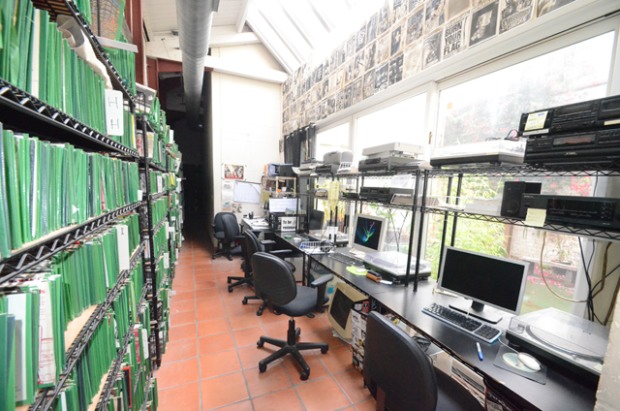
BH: So we have just a few minutes left and I wanted to just kind of close. So, in January it was announced that the zine was in its print run and this came as kind of a surprise to a lot of people. I was wondering if you could just talk about the decision. Paul and Matt are probably most involved and knowledgeable about the decision after 30 plus years of ending the magazine.
PC: Yeah. Well, I mean, there was a lot of stuff that’s like kind of nuts and bolts and not interesting about it. Um, but it came down to people just weren’t buying magazine anymore. People aren’t buying magazines in general anymore. And the cost of living is, you know, ever increasing, especially here in San Francisco. And for a long time, we’ve just been barely squeaking by, and it just kind of one day got to the point where we were just looking at it. And it’s like, it’s just untenable.
MB: And I think it was a matter of like doing it on our own terms rather than like outside forces, like crushing us.
PC: Right. Yeah. We didn’t want to wait until one day we just couldn’t pay the bill.
MB: You know, everybody quits or whatever.
PC: Yeah. So it’s just been this enormous ship to try to stop now. Uh it’s it’s um, Uh, it’s been a rough three months, but it’s also been kind of cool cause like a lot of, a lot of us have had to like band together and really, really make it, make it happen. Um, and then which I’m sure is the next question. Um, a lot of trying to take this energy and just move forward to still being on the web and still like providing what we’ve always done, which is coverage of underground music stuff that you wouldn’t otherwise know about.
MB: Still in the same spirit that, I mean, when you guys are early, early on, like radio show was like this and this it’s like, well, it kind of still is. It’s like all submission based. It’s like, you know, we want to be, if you wanted to come to the house and you were just like some random person, you like call and be like, Hey, can I come around five or whatever and check out the people would come and do research on like the magazine, archives and stuff. And that’s like the kind of spirit we want it to continue. Like with however, you know, we are going to go with this.
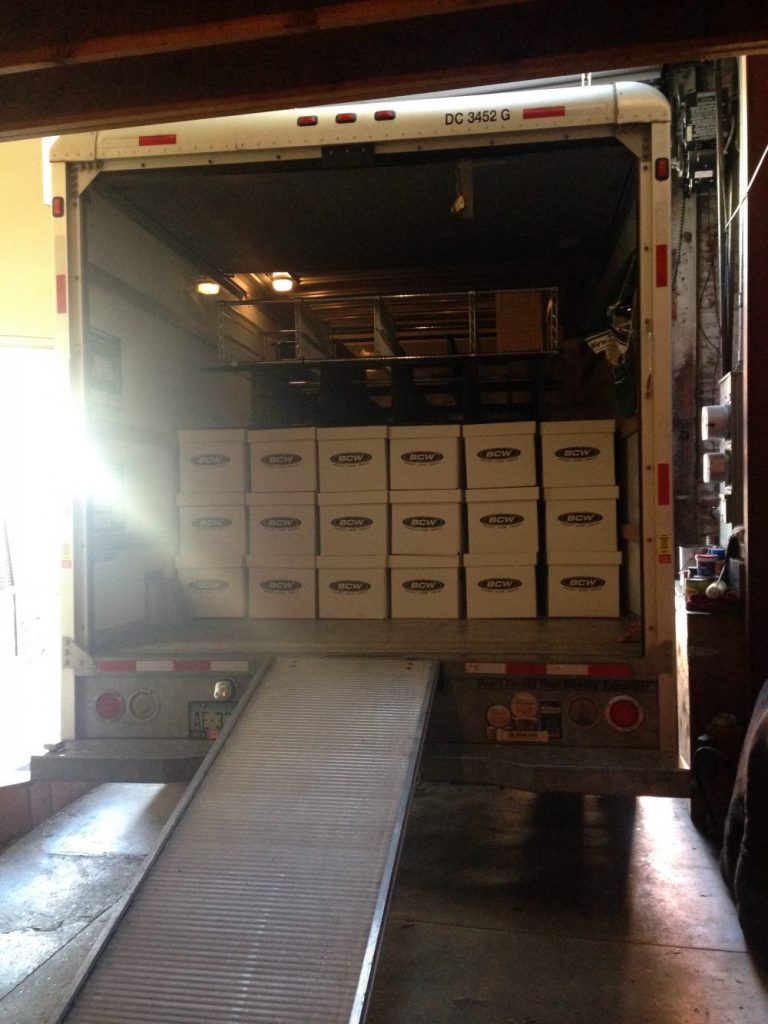
PC: So we’ll still continue to do MRR radio and still continue to write record reviews and do all the things. At least most of the things that the magazine did online, which, you know, isn’t as glamorous, but I have a feeling there’s going to be more people. You know, more, more people reading a website than I have been reading the magazine, even though, you know, everybody, when we announced that it was ending, was just like what the magazine is going away with. Like, if all those people that said what had actually been buying and reading the magazine, then we wouldn’t be in this predicament. So, you know.
BH: And just kind of in conclusion, if you want to talk to just, I mean, especially for, for Paul and Martin, who’ve been involved now since ’83, like what role has, you know, in reflection, what role has Maximum played in your life? And the influence..
MS: It ruined my life.
MB: Come on, you’re here now.
MS: I know, I know. No, it was essential, you know, moving up here when you’re a teenager and still being part of it and just watching it, even when I pulled back, I kind of pulled back a year or two after Tim died. I still kind of kept in touch with everybody, but it just keeps going and going. And that’s a beautiful thing. And Maximum has been going on longer without Tim, than it had with Tim. And it’s just amazing that it’s able to do that, you know, and actually I supported the board’s decision to end the magazine and I always have this thing, just a hypothetical that I think Tim would have shut the magazine down 15 years ago and gone online because it would be free and it would make so much more sense to him. He would have created this online presence that would be probably somewhat unique, you know? But he wouldn’t, that’s my thought he would have killed that thing and just said, no, no mail, nothing everything’s free and go that direction in a positive way, you know, killing the magazine in a positive way, going to the next, next stage.
MB: More accessible.
MS: Yeah. He would love that.
BH: Can you talk briefly about, so you designed the last issue cover? What went into your decision?
MS: It looks good, haha. There is a really weird deep concept there, but it sounds so arty and weird, you know,
PC: Give it to us, break it down.
MS: Oh my God, All right. I mean, as you can see, see, that’s the Discharge face, which is part of it. Well, most well known thing on shirts and stuff. And there’s a weird story behind that is like a face of Mark Stewart from the pop group that nobody knew that was his, uh, his face. And no one knows why Discharge used it. It’s a funny little story, but it’s also, the spray paint kind of represents killing the old and coming with the new, you know, and kind of both of them working together. You know, spray painting, someone’s face a little disrespectful and, there’s another, this is all so lame. No, it just looks good. The other thing is mean to me and Tim always used to talk about, you know, how music started Tim had this theory, that Discharge was the first thrash band and I go, wow. I think you’re right. And he goes, yeah. And so that was a really interesting thing. We never really talked about it publicly, but it was kind of interesting that way. And then putting Never Again on the cover, which is a discharged song. That was not my doing, that was Grace who works at Maximum. And I gave her like half the credit for the cover, because that was the best idea ever. I didn’t think of that. I’m not that clever, but it just made the final issue there. You know, we’re kind of left off some of the information and just said never again. Yeah.

PC: Why did you slap the barcode right in the middle?
MS: Cause it looks good. It’s being honest about it. You know, it’s being honest about the barcode. It’s like not shameful. I’m trying to hide it. Just like here it is. Yeah. But I think I left off the, I kept the date or no date. Right?
PC: We didn’t put the issue number on it.
MS: At first, I tried to not put any of that information on there, but they got mad at me … I didn’t want to put the logo on it. I go, we don’t have to put the logo on it. It’ll sell without the logo. I just, I was trying to do that, but I had a compromise there.
MB: I think it went well.
BH: And what’s it like for you Paul seeing the last print issue?
PC: Yeah. It’s …I don’t know. I had to happen at some point, so I’m glad it happened.
BH: Did he ever imagine when you’re, you know, a teenage kid that you’d be still involved?
PC: No. Nope. Not at all. Not at all. Because especially back then, like, punks didn’t stay punk, you know, like people dropped out when they became adults and got jobs or whatever.
MB: So some of which will probably hear this podcast.
PC: Yeah. But it’s amazing. I mean, there’s, especially in the Bay area, there’s tons of old punks and it’s like, yeah, it’s cool that a lot of us stuck around. And I don’t know to answer your question without, like, I probably won’t be able to without crying, but like, the influence that Tim had was that of being somebody, an adult who encouraged you to participate and gave you the means the tools to participate. And, uh, it’s, it’s weird to think that, you know, in hindsight that like so many people didn’t have somebody like that there, you know, they didn’t even know there was an alternative in the world to doing things the way you were told. And, that’s incredibly fucking special.
BH: And Matt, kind of continuing being part of the team that’s continuing. What do you hope to see for the future?
MB: I mean like, like Paul said, the radio and the reviews will still continue and like, it’s kind of hard to visualize exactly what it’s gonna look like. And we’ve, we’re having a ton of meetings trying to figure out how to like, take this content and like, evolve it, cause it kind of feels like we’re like behind the times in a way, and there’s like this huge space we could have stepped into like before, like social media became a thing. Cause now everybody’s just on that. Maybe we can reclaim some of it and like do this like completely different thing, but it’s just this, yeah, right now we’re, we’re, we’ve been doing logistic stuff the past three months and we’re just kind of at the tail end of that. And then. I mean, we still have enough people like here locally that I think are like invested to keep putting our energy and like uphold all of our principals and everything. And then we have people worldwide too, that are invested in this. And like, it could potentially be this really cool thing that’s way more decentralized where like our, you know, people in like Europe and Southeast Asia and everywhere else can be just as much a part of it as we are and do the same kind of work that we’re doing and creating something that’s like more accessible to everybody rather than then, like having to spend $25 on a magazine if you lived in Indonesia or something, you know.
BH: I think like Martin was saying, that’s like really represents Tim’s idea of bringing voice to, you know, these international communities now with the internet. I mean, you can really achieve those goals almost better than just having the zine holding everything together.
MS: Yeah. But Maximum really did bring the whole international communities almost sooner than anybody else, you know? Yeah. And like bands that nobody ever heard about,
MB: You could see it happen in the first few issues. It’s crazy. It’s like, there’s like a Finland scene report and then like a Brazil scene report. And then there’s this like this Finish Brazilian thing that’s to this day still exists. That’s just because of that.
MS: No, it’s like in first, second, third issue, you know, it’s crazy. So that was an amazing thing about it went global and it still is global total, you know?
PC: It’s like a web of worldwide intersecting ideas and like information
MS: Well put!
BH: So did Tim Yo invent the internet? Is that what you are saying?
PC: W-w-w. Maximum rock and roll.com. Write us mrr@maximumrockandroll.com and get involved.
BH: Thank you so much
Special thanks to BetaBrand for hosting this event. And thanks again to Paul Curran, Martin Sprouse and Matt Badenhop participating in this conversation
Recent Comments